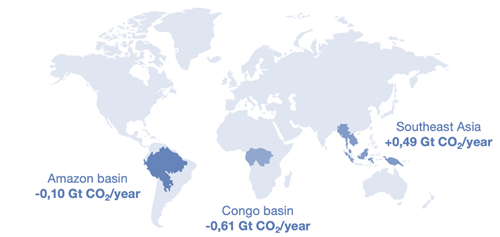Kristof graduated as a Master of Business Engineering at the University of Antwerp in 2018 (major in Corporate Finance and Financial engineering). In his master thesis, he examined the profitability of a momentum strategy on various government bond markets. Kristof joined the team of Econopolis as a Business Analyst in September 2018, focusing on data management and the follow-up of the latest wealth management technologies. Since 2020 Kristof, became Senior Consultant within Econopolis Consulting, a strategic advisory services with a focus on climate and energy transition.
Rainforests at risk: can economics provide the solution?

Rainforests, the lush green giants of our planet, not only harbor unparalleled biodiversity but also serve as vital natural carbon sinks. This article delves into the process by which rainforests act as colossal carbon absorbers, the critical role of three major rainforest regions, and the alarming consequences of deforestation on global carbon emissions.
How do rainforests act as natural carbon sinks?
Rainforests have the ability to function as gigantic natural carbon sinks. Trees utilize atmospheric carbon dioxide (CO2) during photosynthesis to fuel their growth. This carbon is then stored within the trees and in the soil beneath. Most of the carbon in the soil is deposited there through dead plant residues and through the excrement of organisms that live off plants. Some of this carbon is released back into the atmosphere in the form of CO2, while another part is permanently stored. Rainforests, in this regard, are ecosystems that capture enormous amounts of CO2 and subsequently partially store it permanently in the soil. And that is the mechanism behind the natural carbon sink.
The symbiotic relationship between trees and the atmosphere plays a pivotal role in maintaining environmental balance. There are three large rainforests in the world that act as huge carbon sinks: the Amazon basin, the Congo basin, and the rainforests in Southeast Asia.

Figure 1: Rainforests as natural carbon sinks (Source: World Resource Institute, FAO)
From net sink to net emitter
Based on the previous paragraph, you might think that all the numbers in Figure 1 should be negative. After all, rainforests function as natural carbon sinks, so they should be removing CO2 from the air. However, we observe something noteworthy: the net impact of the Amazon Basin, despite its size, is almost zero, and the rainforest of Southeast Asia is even a net contributor to our global emissions. How is this possible?
The answer lies in deforestation. Deforestation in this region has reached a critical point where carbon emissions resulting from the loss of forests surpass the remaining forest's capacity to sequester carbon. This shift has transitioned the rainforest of Southeast Asia from being a carbon sink to a source.
Deforestation has a double effect on the carbon balance:
- Deforestation, whether through burning, clearing for plantations, or draining peat soils, diminishes the carbon sink capacity of forests. Trees and plants, acting as nature's carbon-absorbing machines, store carbon in their biomass and underground structures. Destruction of these vital ecosystems eliminates this natural carbon sequestration process, contributing to increased CO2
- But not only does deforestation reduce the current carbon sink capacity, it also releases stored carbon from the soil and trees into the atmosphere. For example, the Congo basin alone harbors an estimated 29 gigatons of the element “carbon”, equivalent to three years of global greenhouse gas emissions if fully oxidized. The environmental repercussions of such releases are substantial.
Today, the Congo Basin is the rainforest with the largest net absorption capacity. The current capacity is 0,61 Gigaton per year, which is around 50% of Africa’s energy emissions or 6 times the Belgian emissions. However, the Congo Basin, and especially the Amazon rainforest, are also at risk of becoming a net emitter, just like Southeast Asia. This underscores the urgency of addressing deforestation to preserve the delicate carbon balance.
The economic value of the carbon sink
Climate change is a global problem and should therefore be addressed from a global perspective. Our rainforests can play a very important role in this challenge. Currently, deforestation occurs because the human activity causing the forest to give way generates more income than preservation would. That needs to change. Preservation must become an activity that can be economically viable as well. And that's not even so far-fetched: rainforests already have a large, colossal value as global climate regulators, however, this value is not fully internalized yet in our system. Carbon credits can provide a solution. If we were to assign a value of €80/ton CO2 – the current EU ETS price - the annual value of the carbon sink is almost €50 billion, roughly equivalent to the current GDP of Congo. Monetizing this value through carbon credit schemes can provide economic incentives for local communities to participate in rainforest preservation efforts, transforming carbon credits into potential export products. This is, of course, a hypothetical exercise, but it shows the economic significance of this ecosystem.
As the world faces the complex challenges of climate change, understanding the role of rainforests as natural carbon sinks becomes imperative. The economic value associated with preserving these ecosystems not only highlights their environmental significance but also emphasizes the need for global cooperation to ensure the sustainable future of our planet.